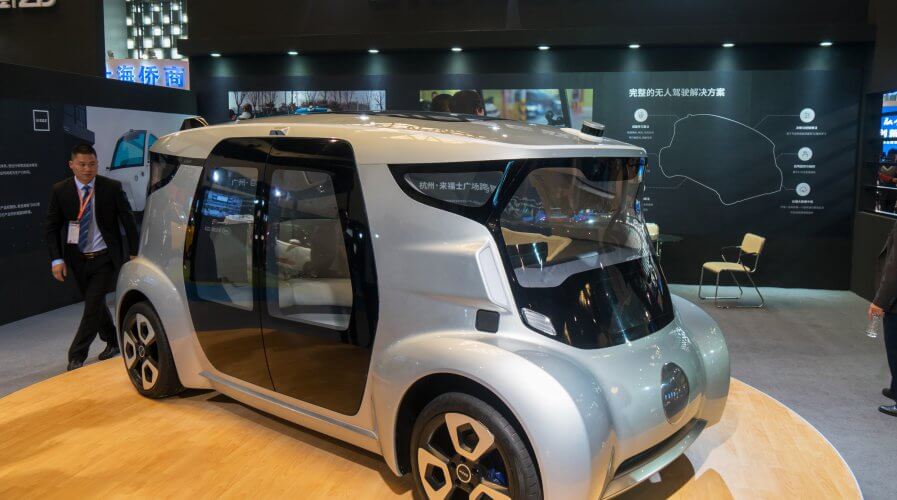
A self-driving car is displayed at the China International Technology Fair in Shanghai on April 19, 2018. Source: AFP
How safe is ‘safe enough’ for self-driving cars?
SELF-DRIVING VEHICLES (SDVs) sound exciting but in light of the recent (and life-threatening) accidents, people are beginning to wonder if they should ever be allowed on the street.
Technologists are therefore deliberating about the initial promise of SDVs and trying to understand whether they can really alleviate traffic issues and increase public safety.
#Tesla Model S sedan involved in this weekend’s fatal accident was not in self driving mode per the company: “We have been able to recover enough data from the vehicle to confirm that Autopilot was not engaged at the time of this accident.” – Tesla @nbcbayarea pic.twitter.com/fkrLVUnW5x
— Bob Redell (@BobNBC) May 23, 2018
A new study published in Risk Analysis examined the question “How safe is safe enough for self-driving vehicles (SDVs)?”
To answer this question, researchers employed an expressed-preference approach – a method that has not previously been employed in this setting – to determine the socially acceptable risk of SDVs.
According to the study, the public will reject the new technology unless it is shown to be safer, approximately four to five times as safe as human-driven vehicles (HDVs).
Despite the conveniences SDVs would bring to individuals, such as the ability to watch a movie, read a book, sleep or surf the internet, the public will be much less likely to accept, or even tolerate, SDVs if they have the same risk level as human driving.
As suggested by previous studies, the study reiterates the fact that people increase their demand for safety when that safety is entrusted to an external factor, such as an automated vehicle.
One of the major motivations behind the development of SDVs is to improve road safety.
Human error causes 94 percent of all traffic accidents in the US and 75 percent of those in the UK.
While SDVs have the potential to significantly reduce such crashes, they also introduce several new road risks, including the risk of being cyber-bullied and “hacked-to-death”.
And while SDVs will never be perfectly safe, regulators will demand that the risk of having them on the road be as low as technically achievable.
The study, conducted by Peng Liu and Run Yang, Tianjin University, and Zhigang Xu, of Chang’an University, surveyed a sample of the residents in Tianjin, China.
Of the 499 respondents, half were randomly assigned to complete a version of the survey for HDVs, while the other half completed an SDV version.
The results of the survey indicate that the respondents believe that SDVs should be four to five times as safe as HDVs.
Based on the results, Liu, Yang, and Xu propose the following requirements for SDVs based on the tolerability of risk in industrial safety (a concept developed in the health and safety field) in which risks are distinguished by three criteria: unacceptable, tolerable and broadly acceptable.
- SDVs that are less safe than human drivers would be set as the unacceptable risk criterion.
- The tolerable risk is that SDVs be four to five times as safe, meaning they should be able to reduce 75-80 percent of current traffic fatalities.
- The broadly acceptable risk criterion for SDVs is set as two orders of magnitude lower than current global traffic risk, indicating a hundredfold improvement over current traffic risks, or the same order of magnitude experienced in public transportation modes, such as rail and commercial aviation.
The researchers hope that their study will help government authorities establish clear safety requirements for regulating SDVs and also help SDV manufacturers better understand consumers’ expectations for SDVs that must be met.
Overwhelmed by issues of safety and financial responsibility, lawmakers push back on self-driving car regulation. https://t.co/dJimxcFwFu
— Haggard & Stocking (@HaggardStocking) April 23, 2018
READ MORE
- Ethical AI: The renewed importance of safeguarding data and customer privacy in Generative AI applications
- How Japan balances AI-driven opportunities with cybersecurity needs
- Deploying SASE: Benchmarking your approach
- Insurance everywhere all at once: the digital transformation of the APAC insurance industry
- Google parent Alphabet eyes HubSpot: A potential acquisition shaping the future of CRM


